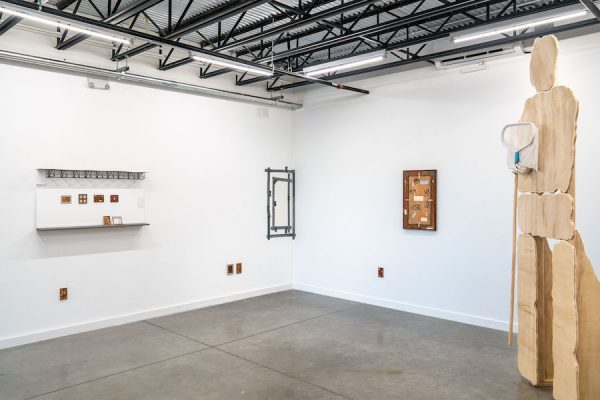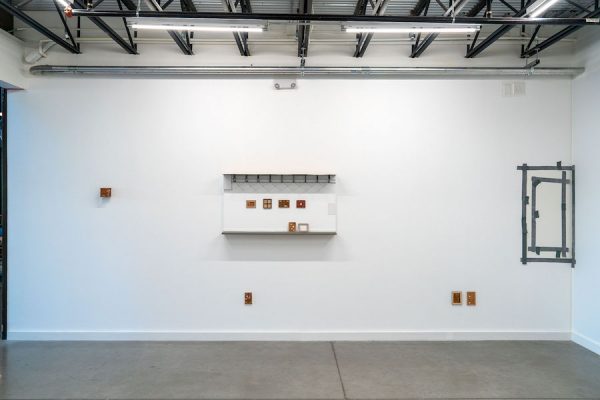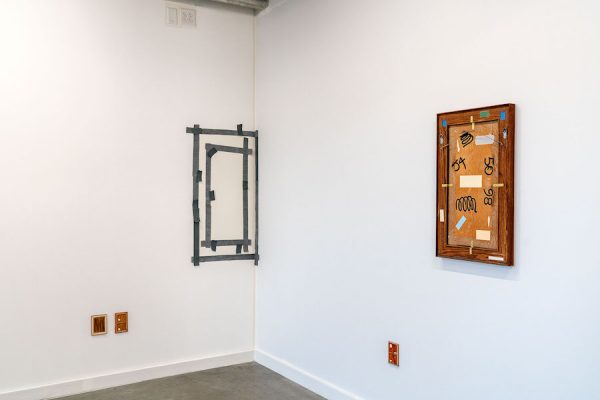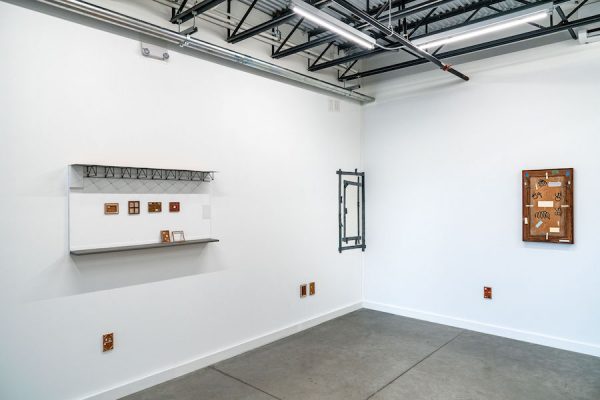
Installation view, Dave Culpepper, That’s not going anywhere, Co-Lab Projects, Austin, TX; September 7-28, 2019; all images courtesy of Co-Lab Projects unless otherwise noted
Last month at Co-Lab Projects in Austin, artist Dave Culpepper presented That’s not going anywhere, a solo exhibition concerned with scale, surface, and simulacra. These recent works made heavy use of models and maquettes, techniques the artist frequently employs at his day job as a museum art preparator. That’s not going anywhere marked Culpepper’s second solo exhibition at Co-Lab Projects; his 2014 offering, Wake Me When It’s Quittin’ Time, was well-received, earning that year’s Austin Critics Table award. Part of Culpepper’s appeal, for critics and audiences alike, is a patent ability to marry technical, craft-focused mastery with a self-aware jolt of absurdism.
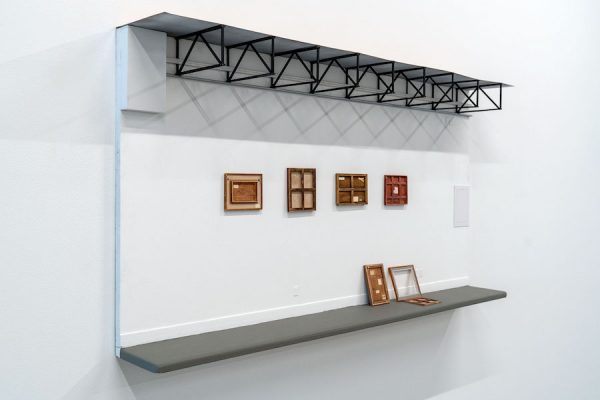
Dave Culpepper, When I grow up… (2019), plywood, basswood, glue, paint, paper, and hardware, 48” x 25” x 7”; plus six individual works (2018-19), basswood, wood stain, glue, paper, tape, pastel, and graphite
When I first entered Culpepper’s exhibition at Co-Lab Projects in early September, I was immediately reminded of Nicholas Buffon, a New York-based sculptor and painter. Buffon is known for his delicate miniatures depicting historic storefronts and residential buildings that invite viewers to slow down and let their eyes meditate on convincing architectural textures the artist conjures out of foam, glue, paper, and paint. Like Buffon, Culpepper is meticulous in the production of facsimiles, though Culpepper’s work varies more significantly in scale. And where Buffon takes inspiration from the public-facing facades of buildings, Culpepper’s work draws primarily from what happens inside the buildings — especially the ones that purport to present and preserve culture. Culpepper frequently pulls objects, tools, and strategies out of the interior depths of institutions and puts them on view for the public, evidencing the artistic and technical labor made invisible by design.
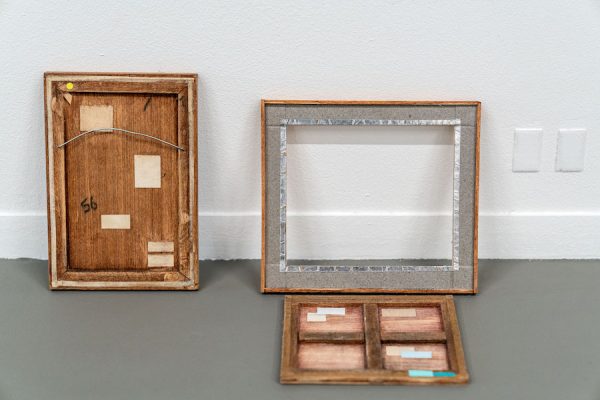
Dave Culpepper, (L) 1987.07 and (R) 1992.56.5 (2018-19), basswood, wood stain, glue, paper, tape, pastel, and graphite, 3” x 4.25 and 4.25” x 3.75”, respectively
When it comes to “full-scale” objects, Culpepper is a sort of Maurizio Cattelan for the working class. The life-size objects Culpepper fabricates are indeed funny and ridiculous, but categorically anti-spectacular. Instead of trafficking in sensational iconography like the Pope being struck down by an asteroid, or a diminutive Hitler kneeling, childlike, in solemn prayer, Culpepper has developed a finessed, quiet symbolic lexicon that carbon-copies the commonplace materials and tools used by laborers. He’s in possession of the patience to pay painfully close attention to the tactility of a faux brick surface, or the thingness of a prop-like strip of duct tape. What’s further remarkable about Culpepper’s work is just how unremarkable some of his objects ultimately appear, rendered so adroitly that they disappear into the ambient visual noise of a room. Many viewers end up missing some of the artist’s works entirely, but he’s quick to point out that this is part of the fun (for him, at least).
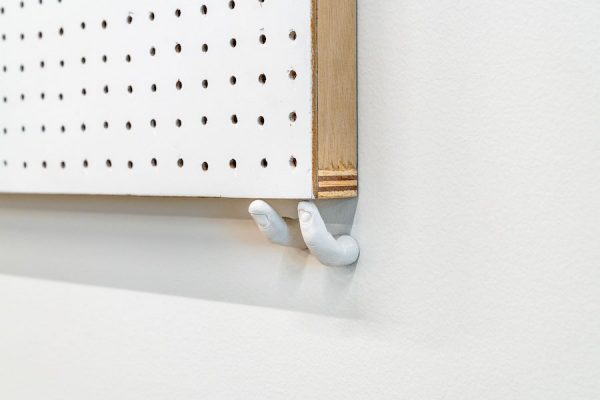
Dave Culpepper, Holy Moly (that doesn’t go there) (2019), plywood, hardware, plaster, and paint, 49” x 28” (detail)
Back in 2010, artist Nina Katchadourian curated a group exhibition titled Day Job at The Drawing Center in New York via an open call to artists. It’s stuck with me for years, as it was one of the first times that I encountered an open conversation, in a major art space, about the relationship between what artists do to earn an income and what they do creatively in their studios. Day Job intentionally did not present the concept of having a job as inherently disruptive. Rather, it specifically aimed to look at “the ways in which the information, skills, ideas, working conditions, or materials encountered on the job can become a source of influence.”
Thinking about Culpepper’s practice over the last few weeks, I wanted to know more about how his day job influenced his studio work. And I wanted to know about his relationship with humor, materiality, and simulation, and how those shape the way his pieces are designed interact with audiences. Thankfully, he was open to a conversation about the aforementioned and more.
Sean J Patrick Carney: Naturally, I want to talk about your recent show, That’s not going anywhere at Co-Lab Projects here in Austin. But first, because I think it affords a particularly germane reading of your art practice, what is your day job?
Dave Culpepper: I am currently Head Preparator at The Contemporary Austin.
SC: What exactly does the Head Preparator do?
DC: My job includes installing and deinstalling artworks, fabricating mounts and pedestals, preparing the galleries, building crates and packing artworks, constructing models and maquettes, and some conservation.
SC: You’ve been working in museums for a while now. Back in 2013, you worked as a Gallery Assistant at the Blanton Museum of Art. In fact, writer Jeanne Claire van Ryzin interviewed you about that very job for the Austin American-Statesman. You described making the rounds, walking ten-plus miles per day, keeping an eye on the art and the museum’s visitors. Was that your first experience peeking behind the institutional curtain?
DC: Yes, and I’m actually glad that you found that article. It was my first experience of that type, and it was an eye-opening one in terms of understanding the entire “back of house” that exists in museums — the myriad of worker roles. I also got a good idea of how the public engaged the museum, and being a Gallery Assistant often felt like being a fly on the wall. You see and hear a lot.
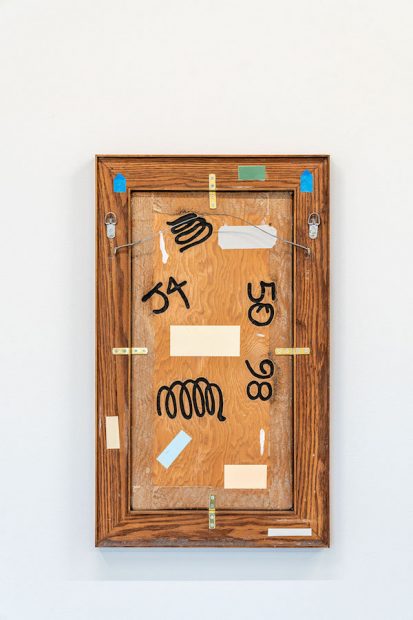
Dave Culpepper, Dust is comprised of 90% of human skin, or something like that (2019), plywood, stain, glue, hanging hardware, paint, plaster, ink, graphite, dust collected from the fronts of paintings, 18” x 30”
SC: Did backstage access change the way that you thought about particular works or periods of art?
DC: Oh yes, it did. In the almost three years that I worked that job, it’s safe to say that my coworkers and I spent more hours in front of those artworks than anyone else. I’ll just say that I went through waves of liking and disliking specific works of art.
SC: That is very judicious of you. What is the job trajectory from there? When did you start working on the more technical side of art exhibitions?
DC: While working at the Blanton, I started picking up freelance art installation work with various private art handling companies, Vault Fine Art Services and Austin Art Services, in particular. I worked installing pieces at various collectors’ homes as well as within institutions. When a position on the Technical Staff at the Blanton opened up, I applied and got the job. That was a position I held for two-and-a-half years, and it involved helping with the redesign and the reinstallation of the Blanton’s permanent collection. Specifically, I worked with the curators of European Art. Shortly after the Blanton’s permanent collection reopened, my current position at The Contemporary was posted. I applied, interviewed, and got the job. And here I am today.
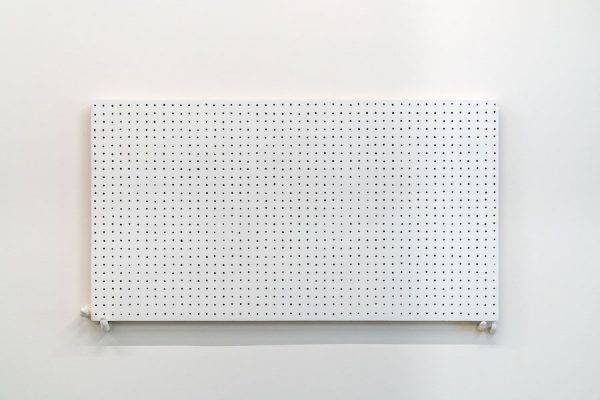
Dave Culpepper, Holy Moly (that doesn’t go there) (2019), plywood, hardware, plaster, and paint, 49” x 28”
SC: There are several instances where fabrication techniques or organizational aesthetics of your various workplaces make appearances in your art. I’m thinking specifically of Holy Moly or My Side First, both of which were included in the recent Co-Lab show. When did those influences start to creep into the studio?
DC: There wasn’t really ever a conscious decision to incorporate my daily routine into my art practice, but they probably started overlapping while I was on the Technical Staff at the Blanton. Serendipitously, perhaps, the processes that I find interesting to employ in the studio happen to bear similarities to necessary, day-to-day processes at work. My preparator job additionally requires a kind of efficiency that has ended up carrying over into my art practice.
SC: How so?
DC: I often find myself compartmentalizing my studio projects, breaking them down into sections and completing them part-by-part. Sculptures or other three-dimensional pieces are mostly planned out before I ever start actually fabricating them, which is clearly related to thinking that’s integral in what I do at The Contemporary. But I have a unique flexibility in the studio that I don’t have at work.
SC: What’s that?
DC: Allowing for happy accidents.

Dave Culpepper, My side first (2018), basswood, wood stain, glue, paper, tape, pastel, and graphite, 3.5” x 3.75” x 3.25”
SC: There also seems to be a real sense of humor beaming out of your studio, especially in this most recent show. Throughout so much of your work, there’s this embedded satire of materiality, a playfulness that makes the very act of participating as a viewer feel pleasantly ridiculous. Where does that come from?
DC: When I was a Gallery Assistant, I really enjoyed watching people interact with objects that were not meant to be received as “art.” Occasionally, something from the cleaning or installation crew would be temporarily left in the galleries, and it was pretty funny to observe a museumgoer trying — generously, I might add — in earnest to evaluate some random object as an art object.
SC: Did you personally ever leave something unattended for a moment that was mistaken for art?
DC: Of course. Once, I stumbled across a visitor evaluating a cardboard sheet that I’d been using to protect the gallery floors while I was doing some painting. I’d already cleaned everything else up, and that was the last item I needed to remove. The cardboard had various drips of paint on it, and was leaned against a wall. There must have been enough going on visually, and with its unintentional placement within the gallery itself, that the visitor understandably thought it could be art.
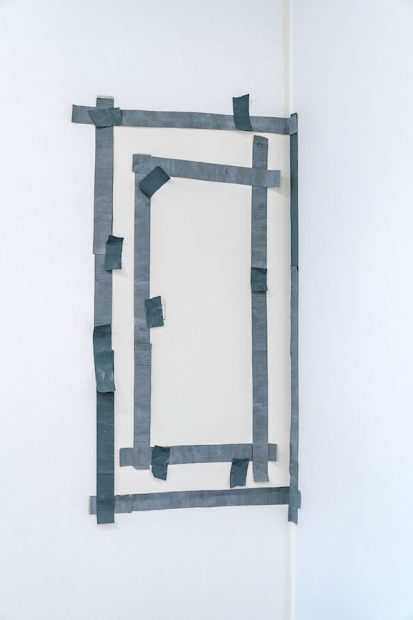
Dave Culpepper, That’s not goin’ anywhere (2019), fiber tape, glue, newsprint, paint, and clear coat, 22” x 44”
SC: That slippage, that interaction mired in misunderstanding, is like quiet slapstick. So much of your work makes use of that.
DC: Honestly, I think about those interactions a lot, and I still find myself paying attention to viewers at The Contemporary, even though it’s not part of the job. Those instances of misunderstanding have inspired recurring themes that appear in my own exhibitions. For this recent show at Co-Lab Projects, I covered up an existing fusebox in the corner of the gallery with what appears to be duct tape. But if you consult the works list, you’ll see that those strips of tape are actually made of FiberTape, glue, newsprint, paint, and clear coat.
SC: That is such a specific material joke. Whom is it for?
DC: It’s for the type of art viewer who is willing to spend a lot of time with materials they already think they understand, on the off-chance that there’s something more there.
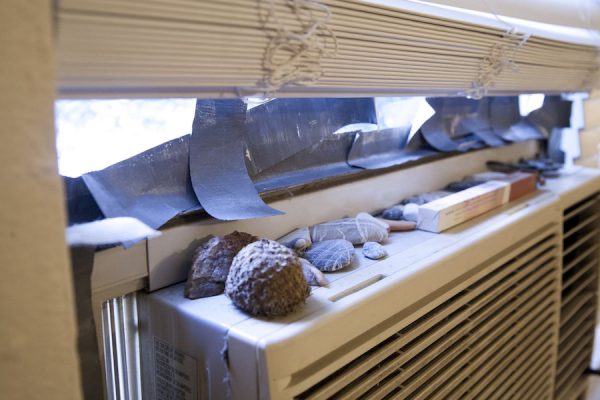
Dave Culpepper, The Climate Controlled (2014), FiberTape, newsprint, glue, paint, clear coat, AC unit, 3’ x 2’; image courtesy of the artist
SC: You’ve used the duct tape trick previously, too.
DC: Yes, in a piece titled The Climate Controlled installed around the air conditioning unit at my 2014 show at SOFA Gallery, Central Air. Additionally, I built a fake attic door, Rise and Run, something that I liken to Wile E. Coyote painting a trompe l’oeil tunnel in at attempt to trick Road Runner. I created an entirely flat representation of a hatch, a practical pathway. An attic door is something that could simply blend into the layout of any house, but SOFA Gallery was located in a residential apartment unit with another unit directly above it. That piece was an allusion to an impossible space.

Dave Culpepper, Rise and Run (2014), wood, rope, wire, spray texture, paint, 3.5’ x 5’; image courtesy of the artist
SC: Are these works meant to be read as punchlines?
DC: Well, as Gallery Assistant at the Blanton, I would sometimes encounter someone in a group cheekily point to a wet floor sign, or a rolling trashcan, in the galleries and chuckle to their friends. You could hear the punchline without them even needing to say it: “Is this art?” The duct tape, the attic door, those are my versions of that punchline.
SC: You mentioned that you often break your projects down into sections, then complete them part by part. How did that work with the miniature works and full-scale works for the recent exhibition at Co-Lab Projects?
DC: It began with my making a few of the miniature pieces before producing the full-scale versions. My original intention was to fabricate scale copies after each miniature, but once I’d completed the first set I ended up being more intrigued with what the miniatures were doing on their own. The making process is something I approach identically, whether I’m producing a miniature or a real panel or frame; I’ll spend one day cutting a sheet and identifying where I want to notch things out for lap joints, then there’s a separate day where I sand and stain the wood.
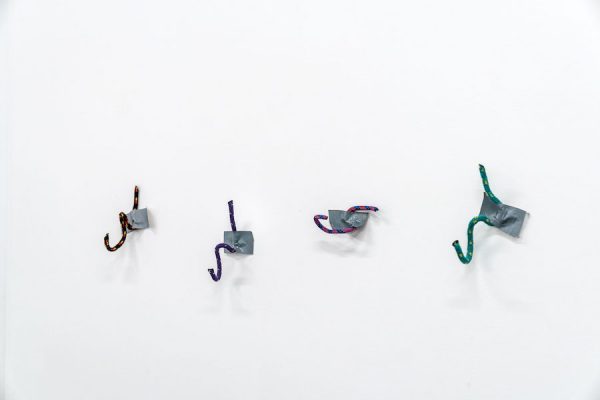
Dave Culpepper, Knot your keys dude (2018-2019), wire, rope, fiber tape, glue, paint, clear coat, 5” x 12” x 4.5”
SC: Where do those cartoonish key hooks come from?
DC: Those are made from rope scraps left over after various rigging jobs. They’re little install mementos you find in the bottom of your tool bag or stuffed into your pocket.
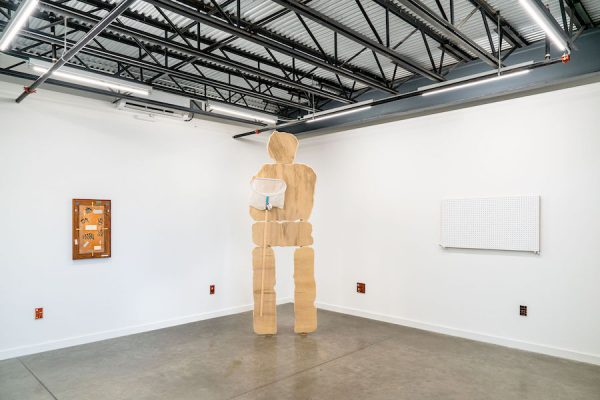
Dave Culpepper, Hugo Boss (second life avatar) (2019), plywood, glue, plaster, pool skimmer, paper, paint, and fiber tape, 36” x 110” x 25” (center)
SC: In reference to maquettes — the simplified, temporary stand-ins that preparators cheaply produce to represent art objects they will eventually install — the press release from your show pointed out that they “serve a purpose and then are abandoned/become useless after their job is finished.” But there was this imposing sculptural work in your show, Hugo Boss (second life avatar) that bore a striking resemblance to Ugo Rondinone’s The True from the sculpture park at The Contemporary Laguna Gloria. Is that the actual Rondinone maquette?
DC: No, the actual maquette I made for The True still lives in the shop at Laguna Gloria. But we have given it a new job; it now holds the pool skimmer and a broom.
SC: Ha! Okay, moving on then. When I grow up… was a near-perfect miniature replica of the very wall upon which it’s hung in the Co-Lab space. For the non-mathematically-inclined, can you give a basic explanation of how you designed it out?
DC: I originally asked Sean Gaulager [Founder, Executive Director and Curator of Co-Lab Projects] to send me some photos of that part of the gallery, as well as the overall dimensions of the wall. From there I selected things in the room that I knew their exact size — like a wall outlet or the fuse box — and then used those dimensions to develop broader dimensions with as much accuracy as I possibly could. That allowed me to establish how large of a piece of wood to cut.
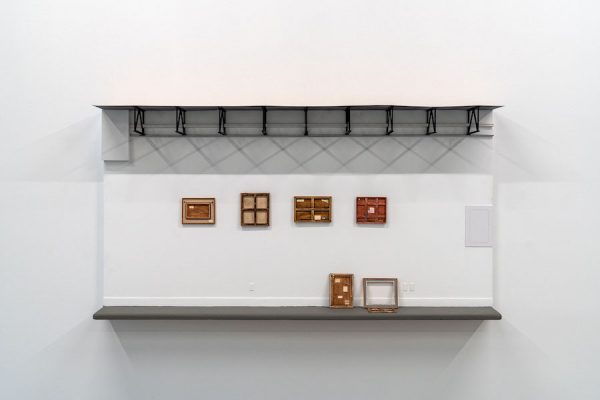
Dave Culpepper, When I grow up… (2019), plywood, basswood, glue, paint, paper, and hardware, 48” x 25” x 7”; plus six individual works (2018-19), basswood, wood stain, glue, paper, tape, pastel, and graphite
SC: So, what is the scale?
DC: Two and one quarter inches on the model are roughly equal to one foot in real life.
SC: That sounds so unbelievably stressful to work with.
DC: Thank you.
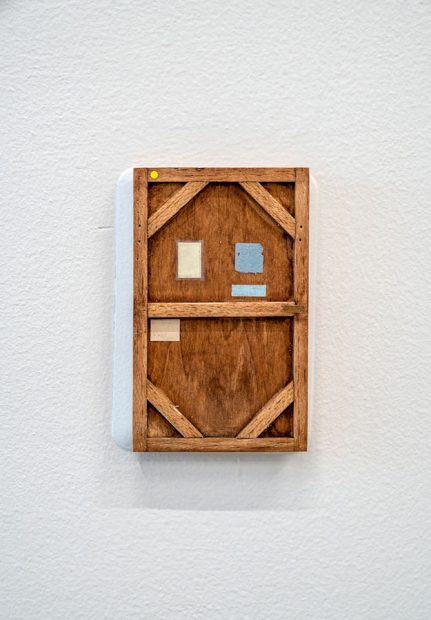
Dave Culpepper, 1967.09 (2019), basswood, wood stain, glue, paper, tape, pastel, and graphite, 3” x 5”
SC: What feeds your attraction to miniatures?
DC: Miniatures offer the opportunity to work out larger ideas without requiring much space. Previously, I’d often make small versions of works in the same way that one might sketch out a painting first. With the recent exhibition at Co-Lab, I decided that I was ready to allow those smaller works themselves to be the finished pieces for the show. Ironically, I wound up spending just as much time, and maybe more, fabricating the miniatures as I would have on full-scale versions. And I do think that miniatures enjoy a built-in cheap trick: they give every viewer a God complex, if just for a moment.
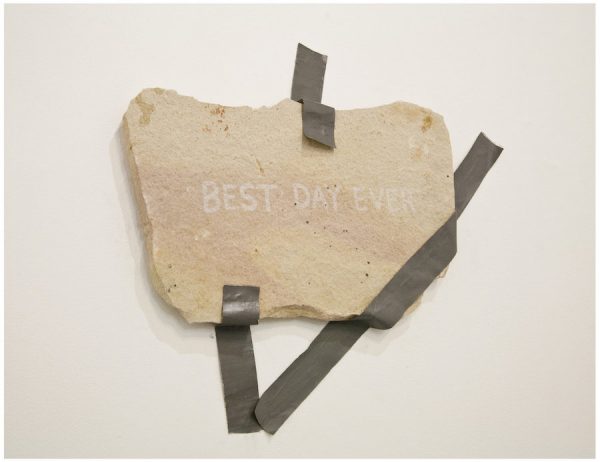
Dave Culpepper, Best Day Ever (2014), paving stone, fibertape, newsprint, glue, paint, clear coat, 2’ x 1’; image courtesy of the artist
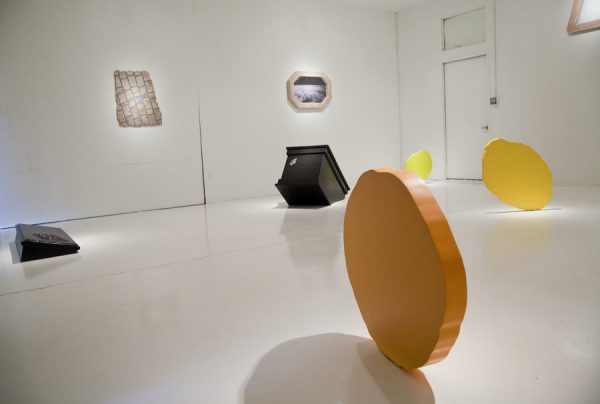
Installation view, Dave Culpepper, Wake Me When It’s Quittin’ Time (2014), Co-Lab Projects, Austin, TX; image courtesy of the artist
SC: There’s an almost trickster element involved when sculptors employ trompe l’oeil techniques, something at least adjacent to prop-making. Does your work have a relationship to the art of the theater or movie prop?
DC: I do relate it to prop making a lot. If something looks like it’s supposed to look — like a rock, for example — you wouldn’t question its materiality until it bounces off someone’s head and you suddenly realize that it’s made of foam. Pieces like Rise and Run or The Climate Controlled or That’s not goin’ anywhere carry all the same material baggage as their real-life counterparts, but the context of the gallery affords an opportunity to think about them differently. These objects were put here specifically, they aren’t just doing their normal day jobs.
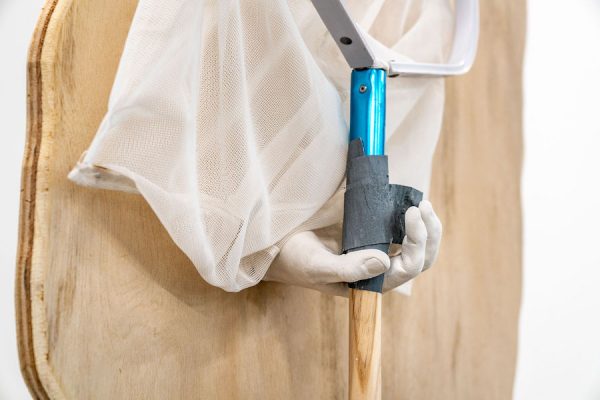
Dave Culpepper, Hugo Boss (second life avatar) (2019), plywood, glue, plaster, pool skimmer, paper, paint, and fiber tape, 36” x 110” x 25” (detail)
SC: What’s in it for you? Why spend all that time painfully making a facsimile when it’s quite possible, likely even, that many viewers will never even notice?
DC: For me, the reward is the actual process of reverse-engineering something like duct tape. You’ve seen duct tape a million times, but there are so many variants. How do I get it to look convincing from every single side? What exact color gray is this gray? Which specific duct tape brand should I be trying to emulate? What would the tape look like after six months?
[INSERT: 20 – Culpepper – Installation View 2019]
Installation view, Dave Culpepper, That’s not going anywhere (2019), Co-Lab Projects, Austin, TX
SC: Let’s say, hypothetically, that there were no more exhibitions, no more audiences. Would you still try to make such highly-detailed replicas and miniatures of everyday objects?
DC: For sure! I honestly just really enjoy making these objects. It’s a challenge and I am always a little surprised at the results.


